1. Choosing a domain name
The first step in creating a WordPress website is buying a domain name. Domain names typically cost between $10 and $15 per year. Thankfully, Bluehost you have very competitive rates, adapted for Wordpress, reliable and secure.
If you haven't registered a domain name yet, I recommend choosing a brand name rather than a generic name.
A brand domain name is different, while a generic domain name is not different.
How to choose a domain name for your brand
- Pick a shorter domain for people to remember.
- Make sure your domain is easy to spell.
- Choose a TLD (top level domain) like.com, .io, or.org.
If your chosen domain name is registered, don't worry. There are over a billion others that are still available, so you have a choice.
2. Choose a web hosting provider
A web host is an essential service for any site to be online. Once you have registered a domain name, you need to register for a website hosting service.
How much does web hosting cost?
WordPress web hosting is inexpensive; it typically costs around $10 per month. Bluehost typically charges $7.99 per month for hosting.
I can offer you a 50% discount since I have a partnership in place to bring your total down to $3.95 per month.
Get instant access to 50% off web hosting with BlueHost
Bluehost is a preferred partner because of the many advanced features it offers, in particular.
- Free domain name for one year
- Free SSL certificate (Socket security layer)
- One-click installation for WordPress (free)
- Unlimited bandwidth, that is, without traffic limitations.
- A very responsive customer support team that is available 24 hours a day, 7 days a week.
3. Set up your WordPress website.
Creating a WordPress site is easy thanks to the one-click installation located in the Bluehost control panel.

Click on the button labeled”Installing WordPress“once you are connected to Bluehost's Cpanel (control panel).
Now that your WordPress website is set up, you should see a basic version of your website.
Set up your SSL certificate
SSL (Socket Security Layer) ensures that your website is secure. If you have already seen the following message appear:
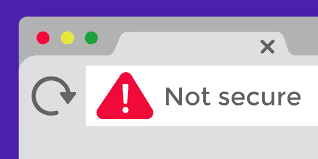
This is because SSL is not configured. It is very imperative to set up an SSL certificate.
Google said that having a secure site is a ranking factor for your site to appear in Google search..
How to set up SSL on your WordPress site
- Sign in to your Bluehost account.
- Click on”My sites“.
- Click on”Manage the site“.
- navigate to the” tabsecurity
- Under”Security certificate“, click on”Free SSL certificate“.
That's all! Don't make the mistake of not setting up an SSL certificate on a WordPress site or any other site on any platform.
Avoid being penalized by Google. Setting up an SSL is simple and only takes 2 minutes.

Look for a lock icon next to your domain name in the web browser after checking the box.
If you don't see the lock icon immediately, don't worry—it may take some time (30 minutes to 1 hour) to appear.
4. Customize the design and structure of your website
Now it's time for the fun part, which is taking ownership of the site by designing and customizing it.
How to set up a WordPress theme
What are WordPress themes?
WordPress themes are pre-designed layouts that are interchangeable. If you want to change your design at any time, you can easily switch to a new WordPress theme. Les Themes are responsible for the beautification of a WordPress website.
While everyone loves beautiful websites, I advise you not to fall in love with a WordPress theme because its design is impressive.
Here are a few things to consider when creating a WordPress website.
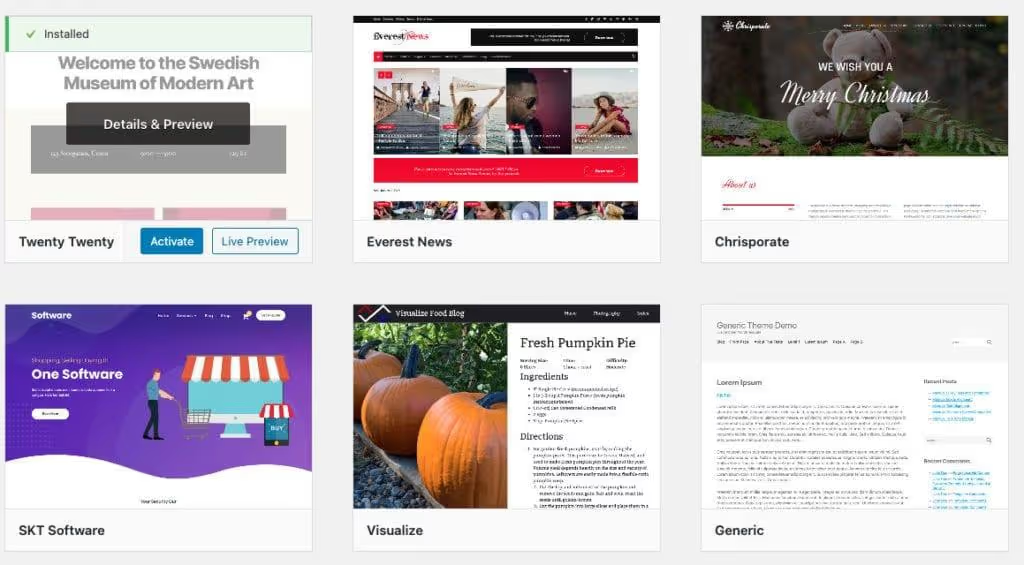
4 factors to consider when choosing a WordPress theme
- Optimized for SEO
- Optimized for speed
- Responsive design (mobile view and desktop view)
- Are there more positive reviews than negative ones?
Be sure to check out what I've listed above. Remember that you prefer functionality to fantasy. If your site looks nice but doesn't work, that's counterproductive.
You can still have a beautiful website, but make sure you're choosing a practical theme to work with.
I strongly advise you not to choose a free WordPress theme. WordPress themes are free for a reason. You get what you pay for.
I've been sifting through WordPress themes designed by professional developers to make sure all the boxes are checked.
Recommended WordPress themes
- StudioPress ( This site uses the authority pro theme )
- Divi Theme by Elegant Themes (page builder included)
How to install a WordPress theme
Once you've chosen a theme and downloaded the theme zip file, go to the WordPress background.
You can access it at any time by typing in the following address: yourcentrename.com/wp-admin.

Enter your username and password that you used when installing WordPress.
- In the left side menu, click on”Appearance“.
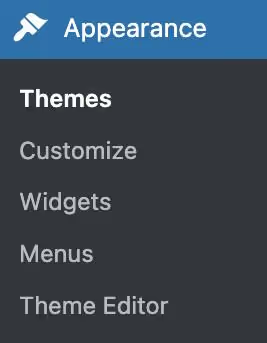
- Click on”Add New Theme”. “Select the zip file for your theme that you downloaded earlier.
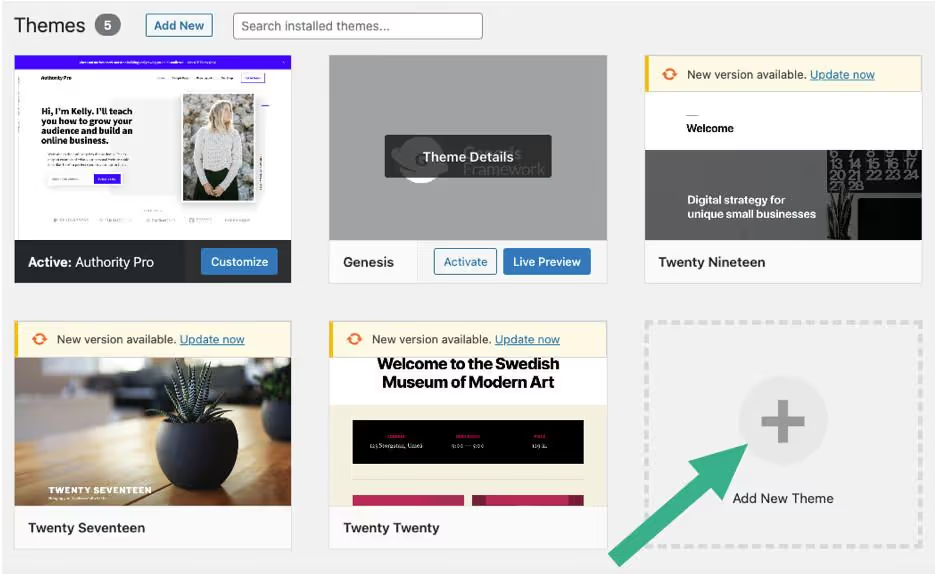
- Click on the” buttonActivate“.
At this point, you will see a success message, which means that the installation was successful.
Make sure to always keep your themes up to date. All you need to do is click on”update now“, and WordPress will take care of the rest.
How to add a logo to a WordPress website
I recommend using Canva.com to create your WordPress logo for several reasons.
- Most are free (buying a premium design only costs $1).
- Models from world famous designers
- Includes an easy sharing option for collaboration
- Automatic saving of all your drawings.
The Canva pro plan gives you access to all design files that you can use for social media messages, business cards, and more for only $9.95 per month.
The price is worth the effort. All the graphic images you see on this site were created with Canva.
Try Canva for free now
Once you've created your logo, go to”Appearance”, click on”customise“. You will then be directed to the menu of your WordPress theme where you can download your logo under”Site identity“.
How to set up a WordPress navigation menu
A navigation menu is essential for directing visitors from one page to another on your site. To add a navigation menu to your WordPress site, go to”Appearance”, click on”menus“.
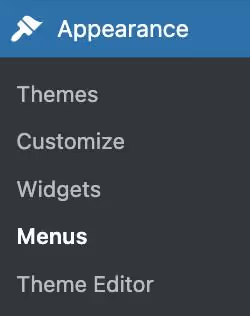
Once you've chosen the menu options, it's time to start creating your navigation menu items.
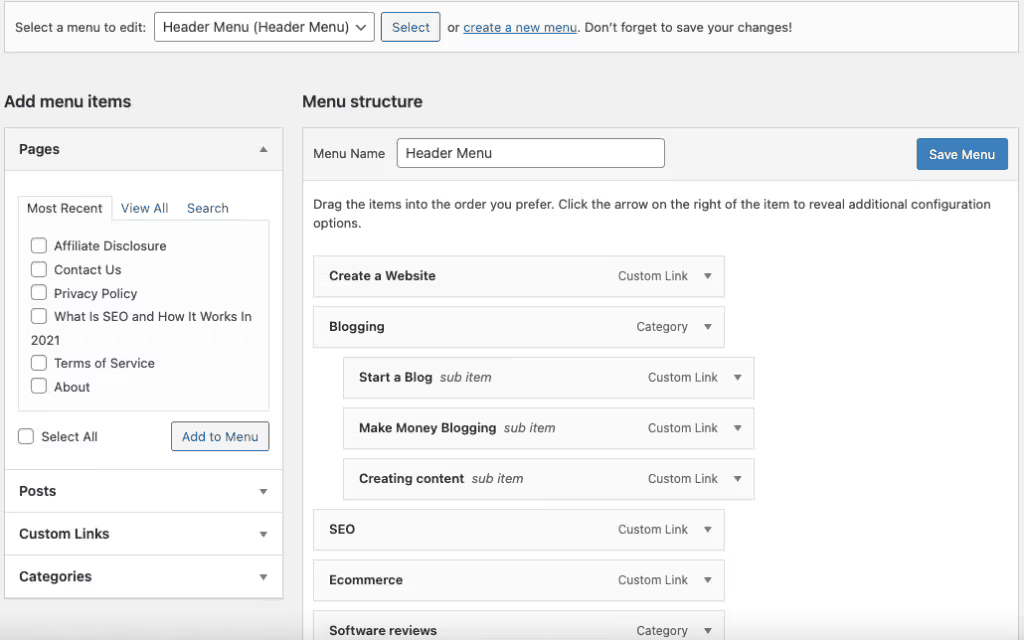
Follow the steps below to start creating your navigation menu :
- Add a menu title.
- Select the pages you want to add to the menu.
- Click on”Add to menu“, then select the pages you want to add.
- Organize links using the “drag and drop” function.
- Save your menu settings.
How to add WordPress widgets
Widgets are blocks of content that appear on your WordPress website. To configure the widgets, navigate to”Appearance”, select”Widgets”.
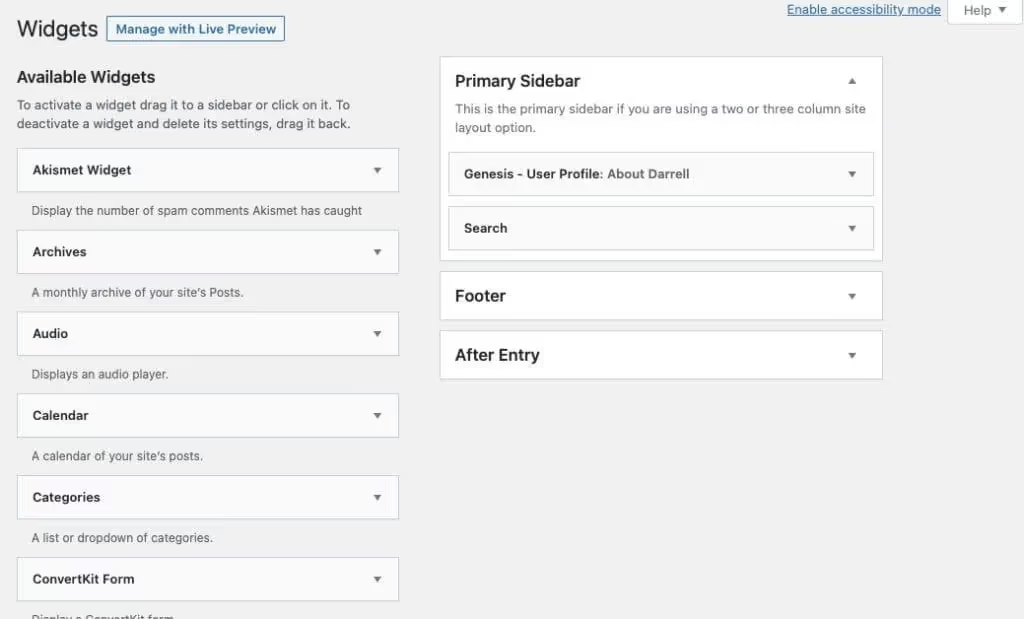
You will be able to view all of the available widgets that come with your theme. Widgets vary depending on your theme.
To add a widget to the sidebar, Drag a widget from the left side, then drop it into the sidebar area on the right side.
5. Adding content to WordPress
Without adding pages and articles to your website, you won't really have a website. Fortunately, adding a WordPress page is quite simple, as it should be, because you will be creating numerous pages and articles.
WordPress pages vs Wordpress articles, what is the difference?
- Articles are treated like blog content. The posts appear in order from the most recent to the oldest on the blog.
- Pages are static, which means that they generally remain the same. For example, the contact page, the home page, etc. The pages are timeless.
Here are the essential pages that most websites include to get you started
- Home page - This is the first impression users get about your site, which requires planning.
- About page - Who are you? This page explains why your site exists.
- Contact page - This page offers users a way to contact you.
- Services page - If you are a business, you want to list your services.
- Store page - If you are an e-commerce store, your products are listed here.
- Blog (display page) - This page has timely content all in one place.
If you want to start a blog specifically, I recommend reading my step-by-step guide.
Additionally, reading my guide to learning how to write a blog post that converts visitors into sales would also be helpful.
For now, we're going to focus on creating a page on your WordPress website.
How to create a page with WordPress
1) Navigate to “Pages” and click on “Add New”

2) Add a title to your page
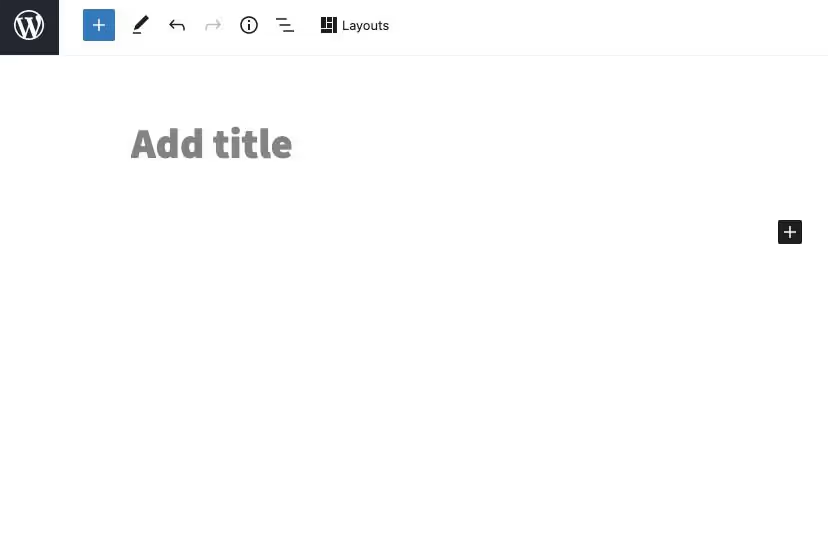
3) Choose a layout

WordPress offers a library of layout templates. To access the layout, click on”layout” in the top section of the page editor. Articles also have the option of using pre-designed layouts.
Creating an article is the same process as creating a page. To create a ticket, simply click on”tickets“instead of”page“.
Now that you have your pages and articles in place, you will need to optimize each page for search engine optimization (SEO). Don't worry, SEO isn't as hard as it seems.
6. On-site SEO implementation
I recommended that you download the All in One SEO plugin. The All in one SEO plugin is one of the most powerful SEO tools for WordPress. Another viable option is to install the Yoast SEO plugin which is a bit more expensive for additional features.
Whichever option you choose, both tools can help you with SEO and are highly recommended.
How to install the All in One SEO plugin on WordPress?
- Navigate to the plugins menu. Click on “add a new one”.
- In the search bar, type “All in one SEO.”
- Click on “Install now”, then on”Activate”.
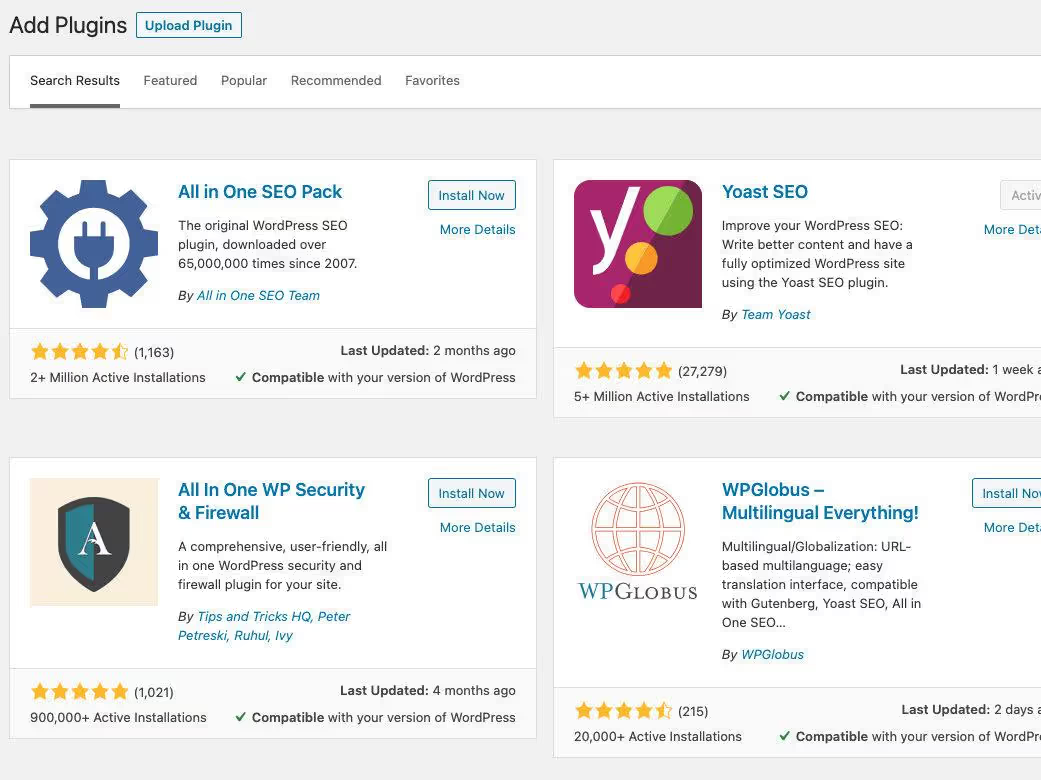
The plugin is now installed on your WordPress website. Configure the plugin as recommended to follow best SEO practices.
If you want to know more about SEO. I recommend that you read my SEO guide. I'm breaking down everything you need to know in detail.
How to set up your permalink structure
You can't do SEO without setting up an appropriate permalink structure. Permalinks are essentially online business cards. This is the URL for your pages and posts.
To set up your permalinks for SEO, go to”settings“and click on”Permalinks“.

Once on the permalinks page, change your permalink to”item name“as a good SEO practice. Disregard all of the other permalink options.
7. Create links to your website
Now that everything is set up on your WordPress site, you need to learn how to create links to attract visitors to your site.
I recommend that you contact bloggers in your specific niche to suggest articles for them to publish in order to create links.
.svg)




